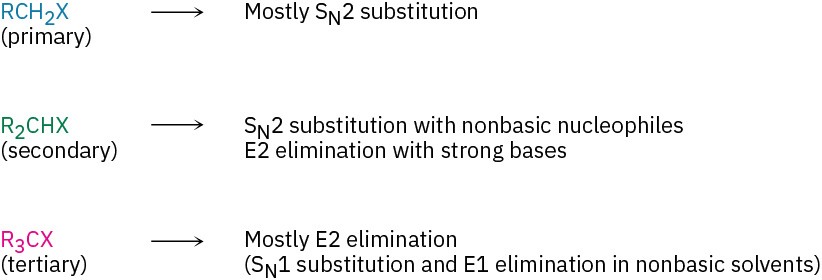Summary
The reaction of an alkyl halide or tosylate with a nucleophile/base results either in substitution or in elimination. The resultant nucleophilic substitution and base-induced elimination reactions are two of the most widely occurring and versatile reaction types in organic chemistry, both in the laboratory and in biological pathways.
Nucleophilic substitutions are of two types: SN2 reactions and SN1 reactions. In the SN2 reaction, the entering nucleophile approaches the halide from a direction 180° away from the leaving group, resulting in an umbrella-like inversion of configuration at the carbon atom. The reaction is kinetically second-order and is strongly inhibited by increasing steric bulk of the reactants. Thus, SN2 reactions are favored for primary and secondary substrates.
In the SN1 reaction, the substrate spontaneously dissociates to a carbocation in a slow rate- limiting step, followed by a rapid reaction with the nucleophile. As a result, SN1 reactions are kinetically first-order and take place with substantial racemization of configuration at the carbon atom. They are most favored for tertiary substrates. Both SN1 and SN2 reactions occur in biological pathways, although the leaving group is typically a diphosphate ion rather than a halide.
Eliminations of alkyl halides to yield alkenes occur by three mechanisms: E2 reactions, E1 reactions, and E1cB reactions, which differ in the timing of C–H and C–X bond-breaking. In the E2 reaction, C–H and C–X bond-breaking occur simultaneously when a base abstracts H+ from one carbon while the leaving group departs from the neighboring carbon. The reaction takes place preferentially through an anti periplanar transition state in which the four reacting atoms—hydrogen, two carbons, and leaving group—are in the same plane.
The reaction shows second-order kinetics and occurs when a secondary or tertiary substrate is treated with a strong base. These elimination reactions usually give a mixture of alkene products in which the more highly substituted alkene predominates (Zaitsev’s rule).
In the E1 reaction, C–X bond-breaking occurs first. The substrate dissociates to yield a carbocation in the slow rate-limiting step before losing H+ from an adjacent carbon in a second step. The reaction shows first-order kinetics and occurs when a tertiary substrate reacts in polar, nonbasic solution.
In the E1cB reaction, C–H bond-breaking occurs first. A base abstracts a proton to give a carbanion, followed by loss of the leaving group from the adjacent carbon in a second step. The reaction is favored when the leaving group is two carbons removed from a carbonyl, which stabilizes the intermediate anion by resonance. Biological elimination reactions typically occur by this E1cB mechanism.
In general, substrates react in the following way:


